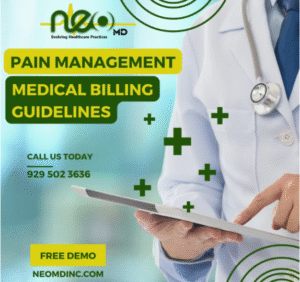Learn The Effective Pain Management Billing Guidelines
Learn The Effective Pain Management Billing Guidelines
Effective pain management billing is a vital aspect of healthcare practices specializing in pain treatment. This comprehensive guide explores the intricacies of billing, covering pain management medical billing guidelines, pain management billing services, and other crucial aspects. In this blog, you will have a thorough understanding of how to optimize your billing procedures and ensure financial stability.
Pain Management Billing: The Basics
Understanding Pain Management Medical Billing:
Pain management medical billing is a specialized branch of medical billing that presents distinct challenges due to its intricate nature. It revolves around documenting and billing for services provided by healthcare professionals specializing in the alleviation of chronic care. Comprehensive documentation is vital to ensure successful reimbursement, which includes detailed records of patient encounters, procedures, and treatments. Furthermore, the billing process involves complex coding, as different procedures, medications, and diagnoses are utilized. So, it’s making it essential for billing staff to be well-versed in the coding system.
Common Pain Management Medical Billing Codes:
In pain management, accurate coding is fundamental for achieving proper reimbursement and ensuring compliance with industry standards. Two widely used code sets in pain management billing are the CPT and ICD 10. CPT codes specifically describe medical procedures and services provided by healthcare providers, including pain management specialists. They define the specifics of the treatment or intervention, allowing insurers to understand the nature and complexity of the services rendered.
Basic Codes for Pain Management:
- CPT Codes These codes are essential in pain management as they detail the procedures, treatments, and interventions performed by pain management specialists. For example, CPT code 64479 is used for epidural injections, and 99202 is a common code for new patient office visits. Accurate selection and reporting of CPT codes ensure that the specific services provided are properly documented for billing and reimbursement.
- ICD-10 Codes: ICD-10 codes are integral for pain management billing as they describe the patient’s diagnosis, helping insurance companies understand the medical conditions and issues that necessitate pain management. For instance, ICD-10 code M54.5 represents lower back pain. These codes are crucial in linking the patient’s medical condition to the services provided and must be chosen carefully for accurate billing.
Pain Management Medical Billing Guidelines
Documents Requirements
In the field of pain management, accurate and comprehensive documentation is of utmost importance when it comes to medical billing. Proper documentation refers to the detailed records that healthcare professionals maintain regarding a patient’s diagnosis, treatment, and overall care. These records are pivotal for the billing process and compliance with healthcare regulations.
Accurate documentation is essential because it serves as the foundation for the medical billing process. Medical billers rely on this documentation to bill insurance companies, government programs, or patients for the services provided. If the records are incomplete or incorrect, it can lead to claim denials, delayed payments, and compliance issues.
Prior Authorization:
Prior authorization plays a crucial role in pain management billing. This process involves seeking approval from a patient’s insurance provider before certain medical treatments, procedures, or medications can be administered. It’s important to understand the significance of prior authorization, the unique requirements associated with different pain management procedures, and strategies to effectively secure this authorization.
To navigate this process effectively, healthcare professionals need to be aware of the specific requirements of different procedures, medications, or tests, as they vary from one insurance plan to another. Moreover, having a well-defined strategy in place for securing prior authorization can help streamline the billing process and reduce administrative burdens for healthcare providers and their staff.
Pain Management Billing Services
The Role of Medical Billing Services:
The role of Outsourcing Billing Services in pain management is to provide healthcare facilities with a specialized solution for managing the financial aspects of their practices. These services involve outsourcing the billing and revenue collection processes to a third-party provider. The main purpose of outsourcing these services is to streamline the operations of the pain management practice. This means that by entrusting the billing functions to experts, the practice can focus more on patient care and less on administrative tasks.
The benefits of utilizing Pain Management Billing Services are highlighted in this section. They include the reduction of administrative burdens, which means that the healthcare facility doesn’t need to handle the complex and time-consuming task of billing and collections in-house. Instead, experts take care of it.
Choosing the Right Revenue Cycle Management Services Provider:
If you’re contemplating the idea of outsourcing your pain management billing services, this guide will help in selecting the right service provider. Choosing the right Revenue cycle management companies is critical to ensure that your billing and revenue collection are handled effectively.
Optimizing Your Billing Process
Reducing Billing Errors:
In the context of pain management billing, it is crucial to address common billing errors to optimize the financial process. This involves identifying and rectifying issues such as coding errors, incomplete documentation, or inaccuracies in patient information. By effectively minimizing these errors, healthcare providers can ensure a smoother billing process, expedite claims processing, and ultimately maintain financial stability.
Staying Compliant:
Compliance with healthcare regulations is of utmost importance in pain management billing. This encompasses adhering to federal and state laws, as well as following specific guidelines and regulations related to pain management services. By staying informed and actively maintaining adherence to compliance standards, healthcare providers can avoid legal repercussions and financial penalties, ensuring the integrity of their billing process and upholding the trust of patients and regulatory bodies.
Insurance and Reimbursement in Pain Management
In the realm of Pain Management, the interaction between insurance and reimbursement is a complex web that demands thorough comprehension. We will delve into various insurance models, the intricacies of billing cycles, and effective strategies to optimize reimbursements, helping healthcare providers navigate this critical aspect of their practice.
Billing for Multidisciplinary Pain Management Clinics
Multidisciplinary Pain Management Clinics bring unique billing challenges to the forefront. This section focuses on the nuances involved in billing for interdisciplinary services, shedding light on the complexities and offering best practices that can help clinics effectively manage their billing processes.
Technology and Pain Management Billing
Technology is a vital tool in the healthcare landscape, and its role in billing for Pain Management is no exception. We will examine how technological advancements, such as Electronic Health Record (EHR) systems and specialized billing software, can streamline billing procedures, improving efficiency and reducing errors in the process.
Staying Up-to-Date with Pain Management Changes
Healthcare regulations and billing guidelines are ever-evolving, necessitating constant vigilance. Understanding how to keep up with these changes and adapt your billing practices accordingly is crucial. This section will equip you with the knowledge and strategies needed to stay current, maintain compliance, and maximize reimbursements in the ever-shifting world of Pain Management.

What Stand-Out NEO MD Medical Billing Services?
NEO MD stood best among competitors’ Revenue Cycle Management Companies due to the following cores;
- Our experts work hard to reduce your front-end denials by 20%.
- Claim first level acceptance ratio; 95-97%
- Offer Provider & Staff Productivity Analysis
- Refunds adjustment and Payment posting to improve the cash flow.
- Provide fortnightly financial and practice overviews
- We have consistently increased the collection rate for our clients because of the faster increase in the accuracy of fees and collection.
- Successfully opens insurance panel for providers
- Offer internal Medical Billing audits to uncover loopholes
- Offering state-of-the-art medical billing services for small practices, medium-sized, and large ones.
- Use the latest technology and tools.
- Out of Network Negotiations.
- Provide unrivaled Medical Billing Services that are of high quality and error-free.
- Deliver customized Revenue Cycle Management Services to unearth operation shortcomings.
Conclusion
Effective pain management billing is fundamental for healthcare providers in this specialized field. By following the comprehensive guidelines and best practices discussed in this blog post, you can ensure timely and accurate reimbursement. Whether you choose to manage billing in-house or consider professional service assistance, staying compliant is the key to success.
By implementing these guidelines and considering the use of revenue cycle management services, you can enhance your practice’s financial stability while providing high-quality care to your patients.





